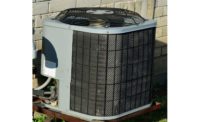When servicing equipment, refrigerant recovery is a legal requirement. It has been a mandated part of the servicing process since 1993. However, we still receive a number of questions, which raise our concern for the safety of service technicians when performing this essential function. Therefore, we thought it timely to provide some tips that can help you recover refrigerants safely and avoid possible personal injury or damage to your equipment. Many of these recommendations are the same as for handling refrigerants in their original container.
SAFETY RECOMMENDATIONS
• Use personal protective equipment including safety glasses with side shields, gloves, and safety shoes when filling and handling recovery containers. Use a hard hat if required for the work area.
• Avoid skin contact with liquid refrigerant because it can cause frostbite.
• Because refrigerant vapor is heavier than air, it will concentrate in low areas. Avoid these areas unless proper ventilation is provided.
• Avoid inhalation of refrigerant vapor. Be aware that inhalation of high concentrations of refrigerant vapor is harmful and may cause heart irregularities, unconsciousness, or death.
• Recovered refrigerant will typically contain some amount of oil, which can appear as a white cloud or fog. Do not breathe oil mist if it should be emitted during the recovery process.
• Exercise caution when moving filled recovery containers.
• It is recommended that all service technicians periodically review the product MSDS to be reminded of important safety information.
Some additional recommendations apply specifically to the recovery process and recovery cylinders:
• Prior to filling, inspect the recovery container and valve for signs of damage, such as dents or corrosion. Do not fill a damaged recovery container.
• Make sure the cylinder is properly labeled with the type of refrigerant.
• Do not mix refrigerants in the recovery cylinder.
• Ensure that the recovery equipment, recovery cylinder and hoses are rated for the refrigerant you are recovering; check with your equipment supplier.
• Do not overfill the container.
• Recovery cylinders should not be filled if the present date is more than five years past the test date that is stamped on the shoulder of the cylinder.
CYLINDER SELECTION AND HANDLING
Due to their higher pressure, R-410A and R-402A (HP-80) must be recovered in a 4BA400 or 4BW400 high-pressure recovery cylinder. Some refrigerants like R-422A, R-422D, R-407C, R-404A, R-408A, and R-507 can be recovered in a standard 4BA300 or 4BW300 recovery cylinder; however, these same refrigerants must be recovered in a high-pressure 4BW400 half-ton recovery tank since the lower pressure half tons are only rated for 260 psig. For recommended recovery cylinders by refrigerant, please consult the manufacturer/refrigerant supplier.
Do not overfill the cylinder. Liquid refrigerant will expand as its temperature is increased. If the cylinder somehow becomes completely full of liquid, the pressure can increase dramatically with a relatively small increase in temperature.
Refrigerant manufacturers and others who fill cylinders have to know how much refrigerant to put in the cylinders so as not to become liquid full under normal storage/use temperatures, and even at temperatures that far exceed these normal conditions. Now that recovery of used refrigerant is becoming a common practice, contractors and service technicians also need to understand this.
Typically, the cylinder should not be filled to more than 80 percent liquid full at 77°F. Another guideline is to not exceed the gross weight (total weight of the container and its contents). Check with your refrigerant supplier or reclaim provider for specific recommendations.
Most people in the HVACR industry who routinely handle refrigerant cylinders understand the concept of “saturation pressure vs. temperature.”
When there is some amount of liquid refrigerant in a cylinder, the pressure associated with a given temperature will be the saturation pressure. This is the information that is provided in pocket P-T charts that are commonly used in the industry.
If there is only refrigerant vapor in the cylinder, then the vapor is described as a “superheated vapor” and the pressure associated with a given temperature does not follow the standard P-T curves.
If the cylinder somehow becomes completely full of liquid, then other pressure-temperature relationships take over and there is the possibility of an unsafe situation. In a “liquid full condition” the pressure in the cylinder can increase very rapidly with relatively minor increases in the temperature. The design pressure of the cylinder can be exceeded and the cylinder relief valve could begin to vent the high-pressure refrigerant. In a worst-case scenario, the cylinder could burst, causing property damage or personal injury. Table 1 shows pressure-rating data for two commonly used recovery cylinders.
R-22 COMPARISONS WITH R-410A
To demonstrate the effect of temperature and pressure, a series of calculations were conducted on R-22 and R-410A. Fig. 1 assumes that a recovery cylinder, filled with R-22, was properly filled to a safe liquid level of 80 percent at 80°. As the temperature increases, the liquid refrigerant expands inside the cylinder, but the pressure will still follow the saturated P-T curve until it becomes liquid full at 145°.
At this point the pressure begins to increase rapidly with increasing temperature. In most normal situations, a cylinder would not reach this temperature unless it is in a fire or stored in a location subject to very high heat loads. The minimum relief valve setting for a DOT-4BA300 cylinder will be exceeded if the cylinder reaches 145°.
Fig. 2 shows the same information as Fig. 1, but with additional information on R-410A. It is interesting to note that R-410A starts out at a higher pressure, but does not increase as rapidly in pressure as R-22 when the cylinder becomes liquid full at 145°.
Fig. 3 shows R-22 with two additional curves. These two curves assume the cylinders are improperly overfilled to 90 percent and 95 percent liquid level at 80°.
As indicated in the graph, these two cylinders would become liquid full at a much lower temperature (about 130° and 105° respectively). In these two situations, it is much more likely that the relief valve would be activated, especially for the cylinder that was improperly overfilled to 95 percent liquid full. It is also possible the cylinder burst pressure could be exceeded.
The relief valve is designed to prevent this from happening. But in an extreme case, such as a fire, the capacity of the relief valve could be exceeded.
Note: R-22 was used as an example because it is broadly used and familiar to most in the HVACR industry. Most other commonly used refrigerants would exhibit very similar behavior under similar conditions.
BOTTOM LINE
When recovering used refrigerant, follow the recommended practices summarized above. Thoroughly inspect the cylinder you will use and ensure it is designed to handle the pressure of the refrigerant being recovered. EPA has also established under Section 608 that refrigerant recovered and/or recycled can be returned to the same system or other systems owned by the same person without restriction.
If refrigerant changes ownership, however, that refrigerant must be reclaimed (i.e., cleaned to the ARI 700-1993 standard of purity and chemically analyzed to verify that it meets this standard) at an EPA-certified reclamation facility. Remember that R-410A re- quires a DOT-4BA400 or 4BW400 recovery cylinder. Never overfill the recovery cylinder.
DuPont offers reclaim services to its distributors for all of its refrigerants and is available to assist with questions regarding your recovery needs. Further information can be obtained at www.refrigerants.dupont.com or 800-235-7882.
Publication date: 01/29/2007









Report Abusive Comment